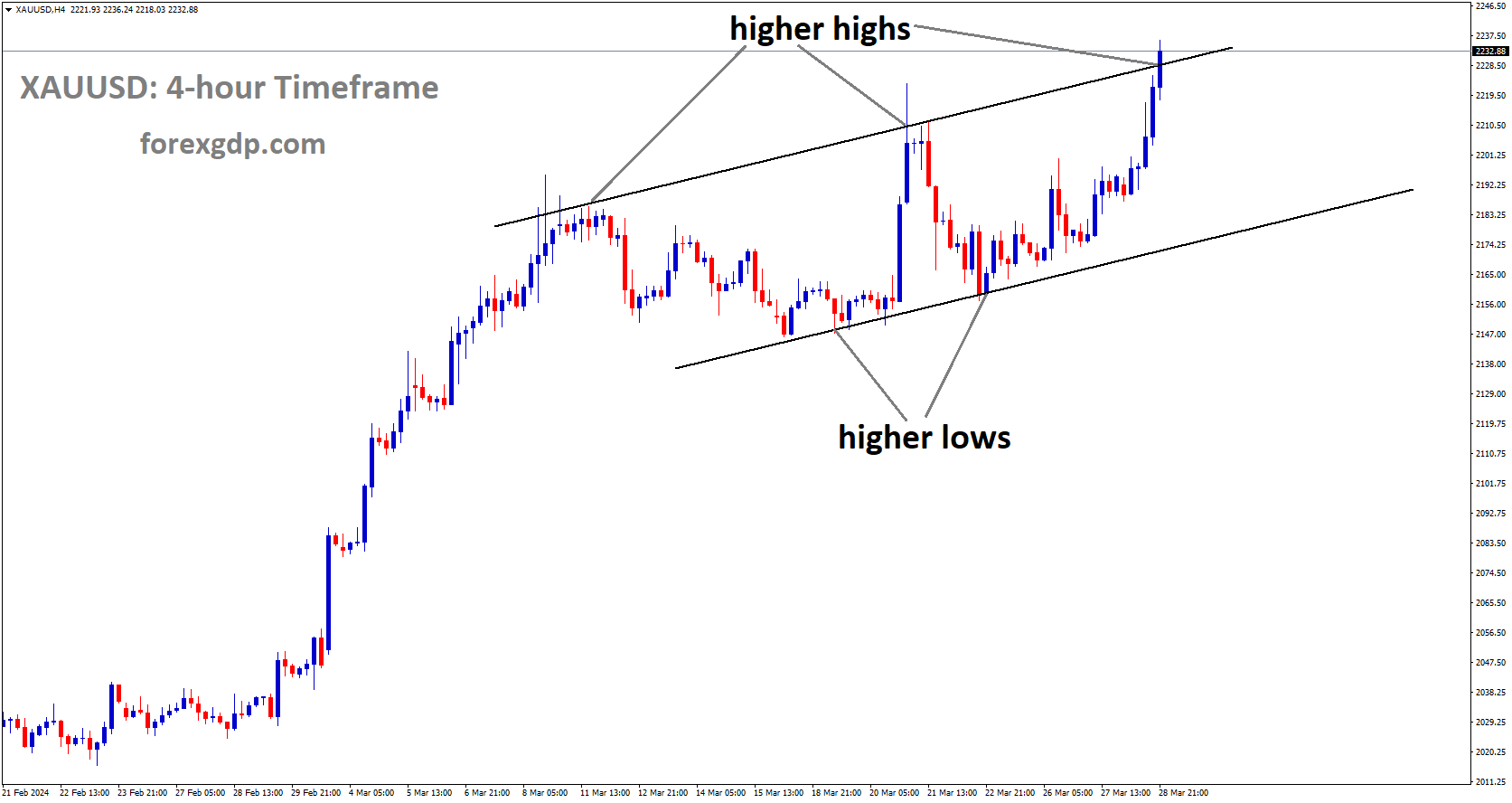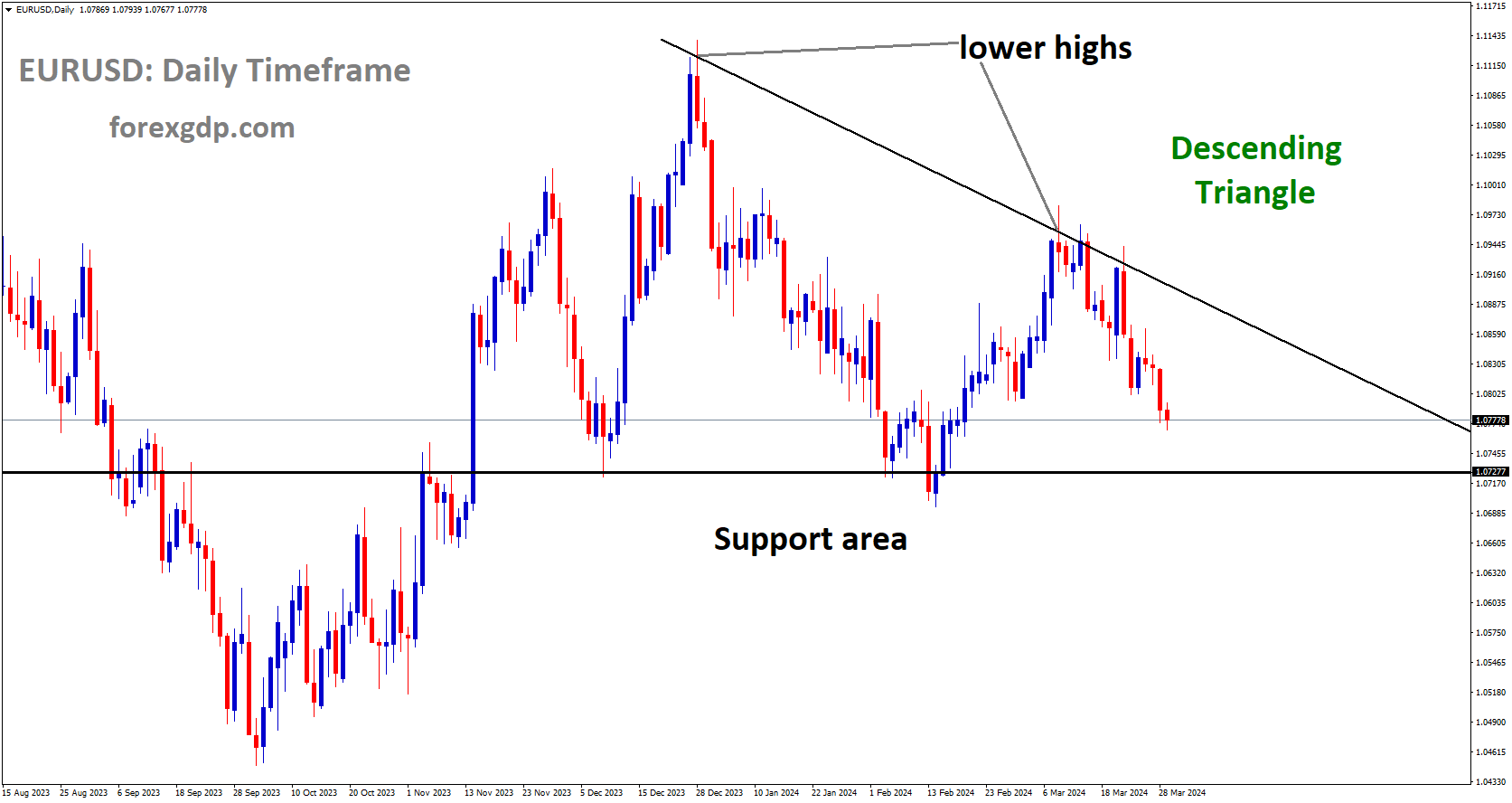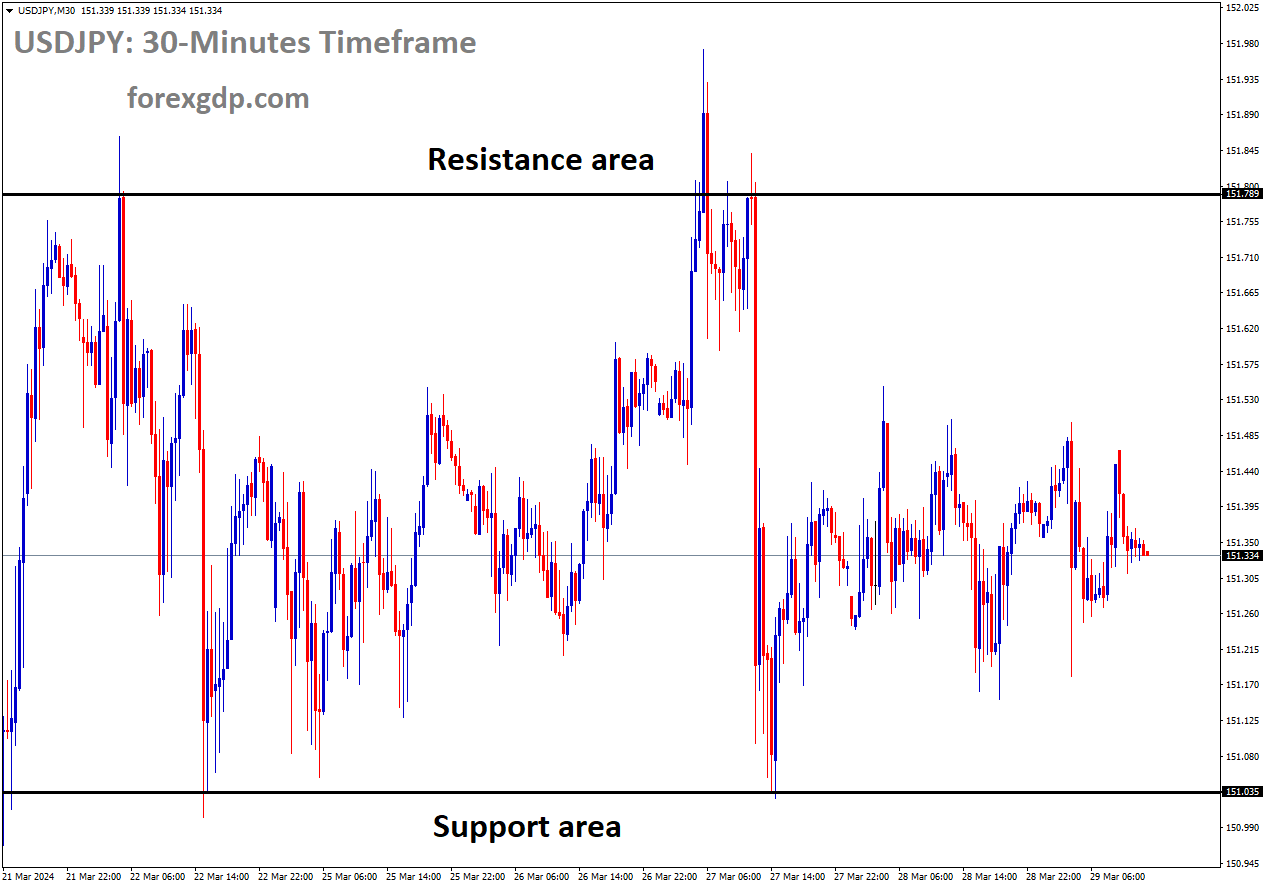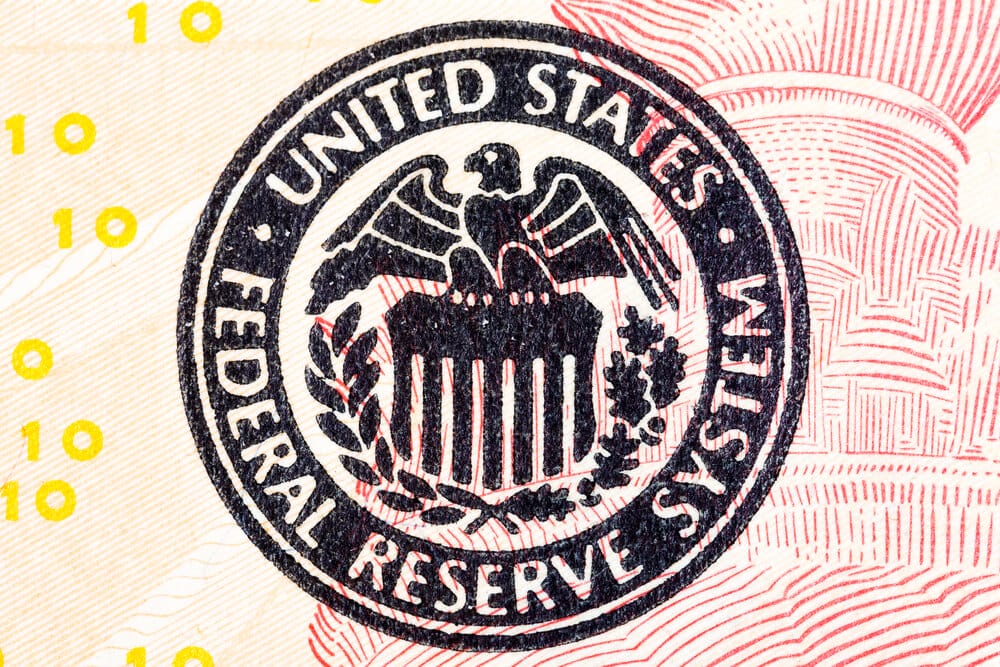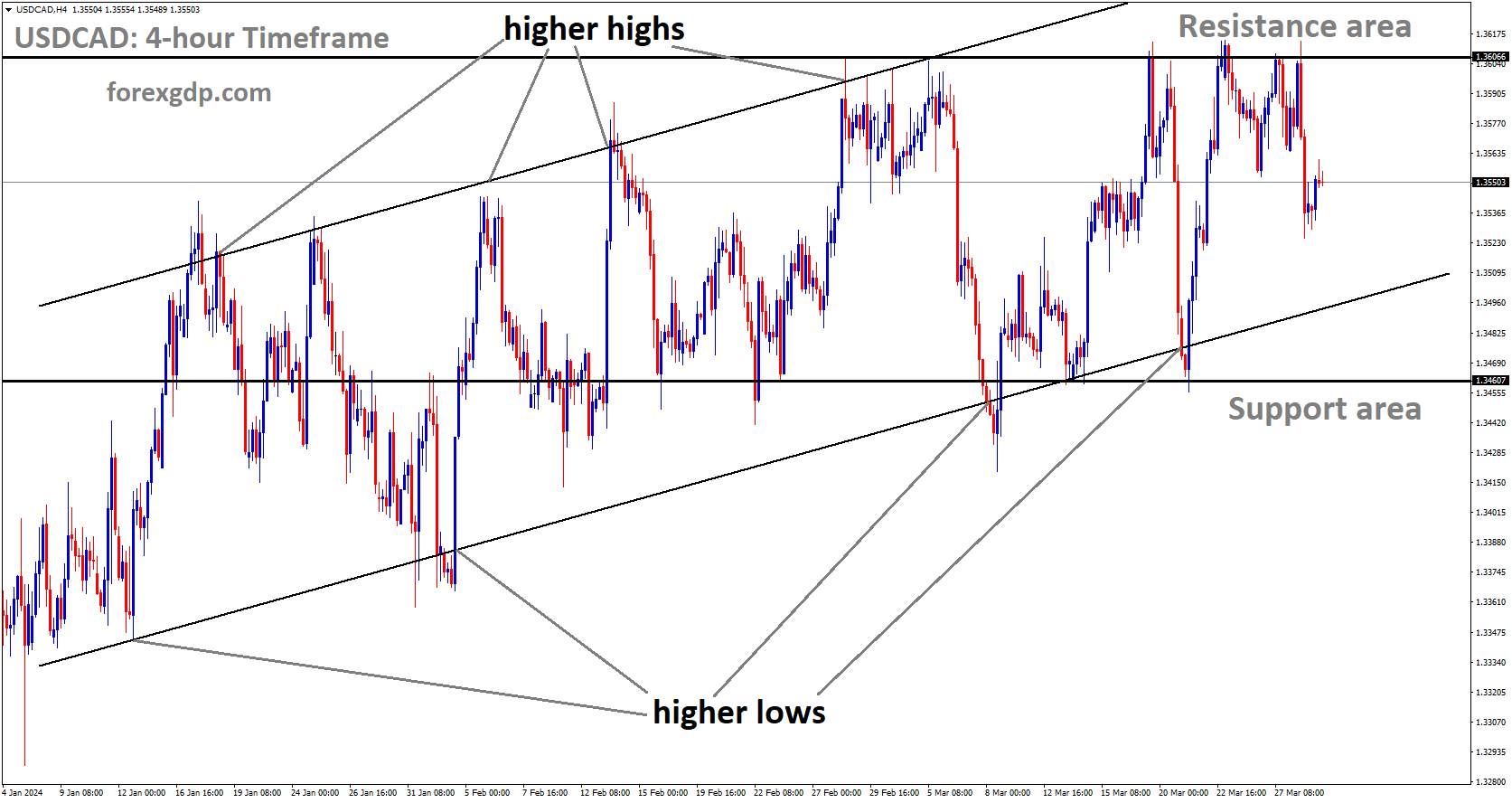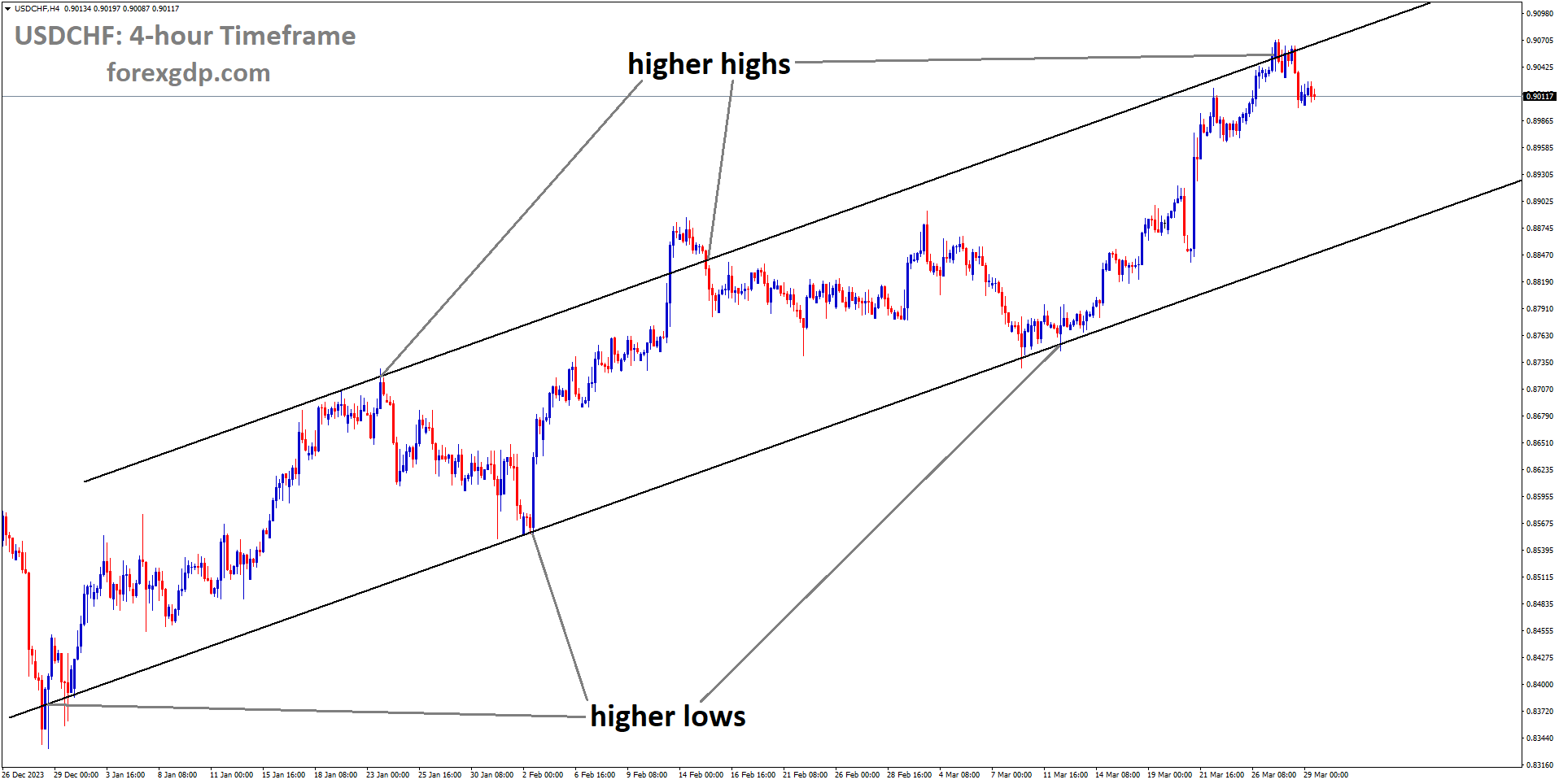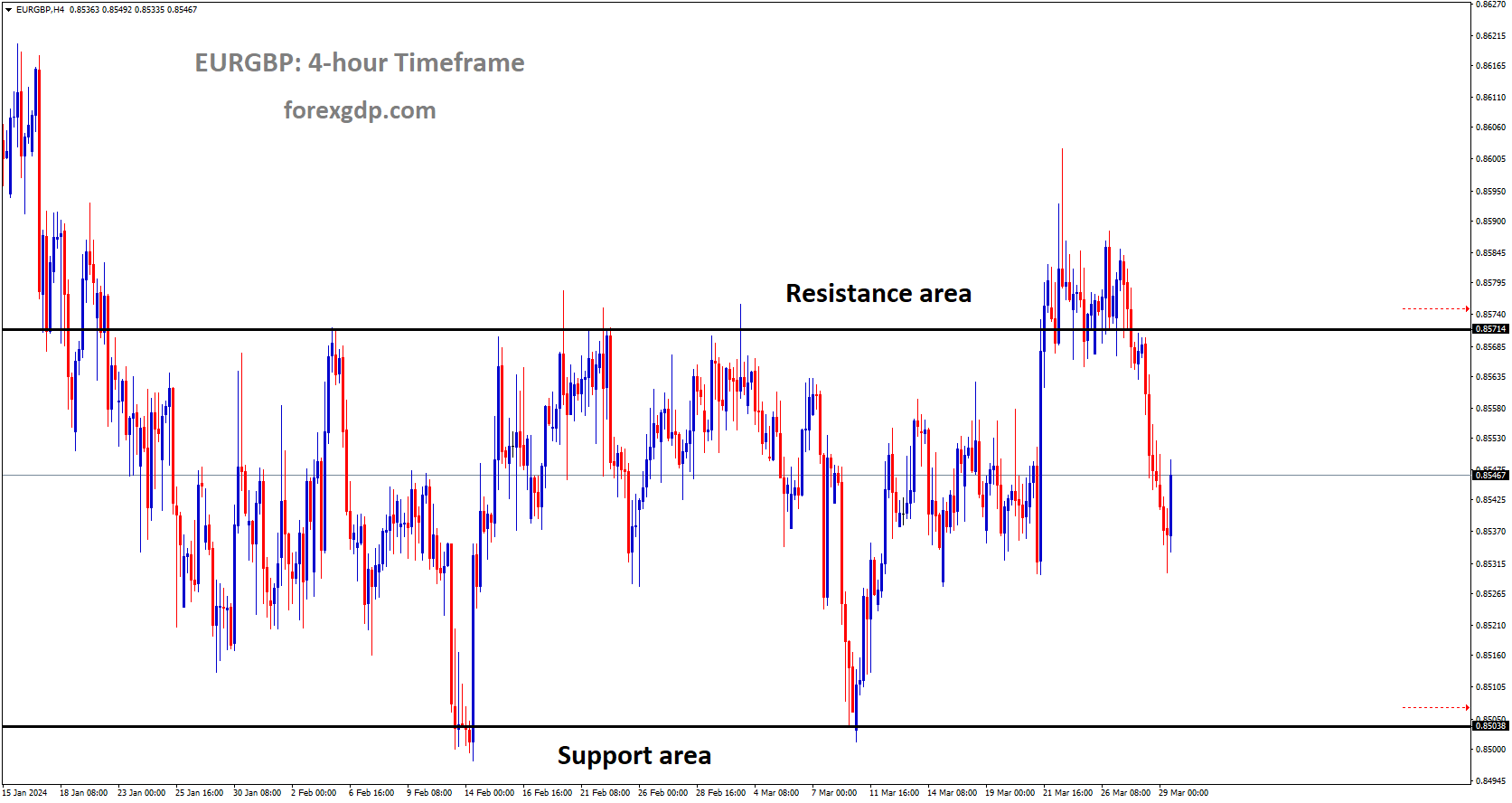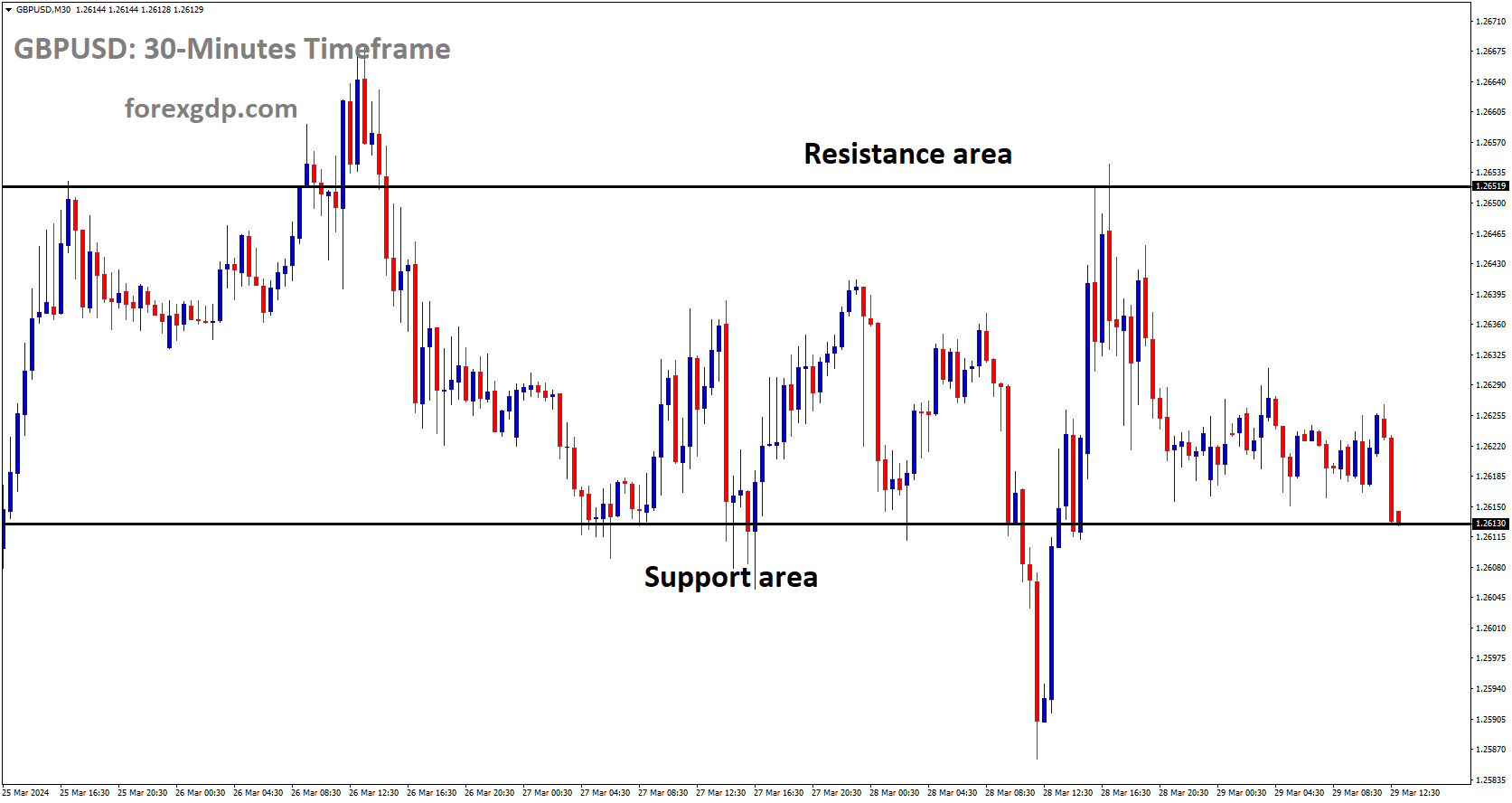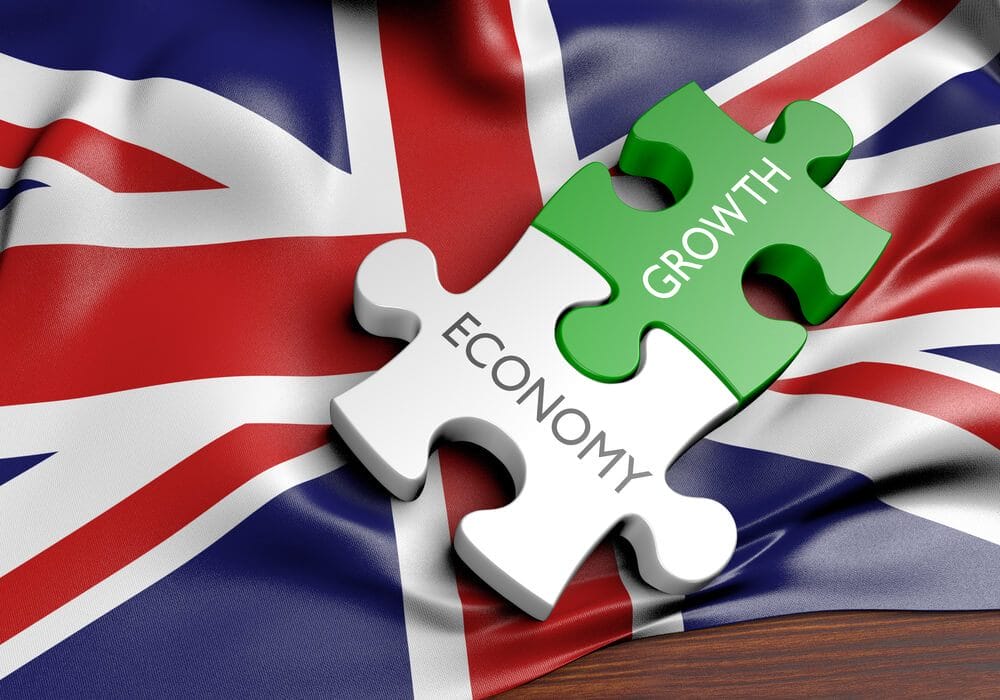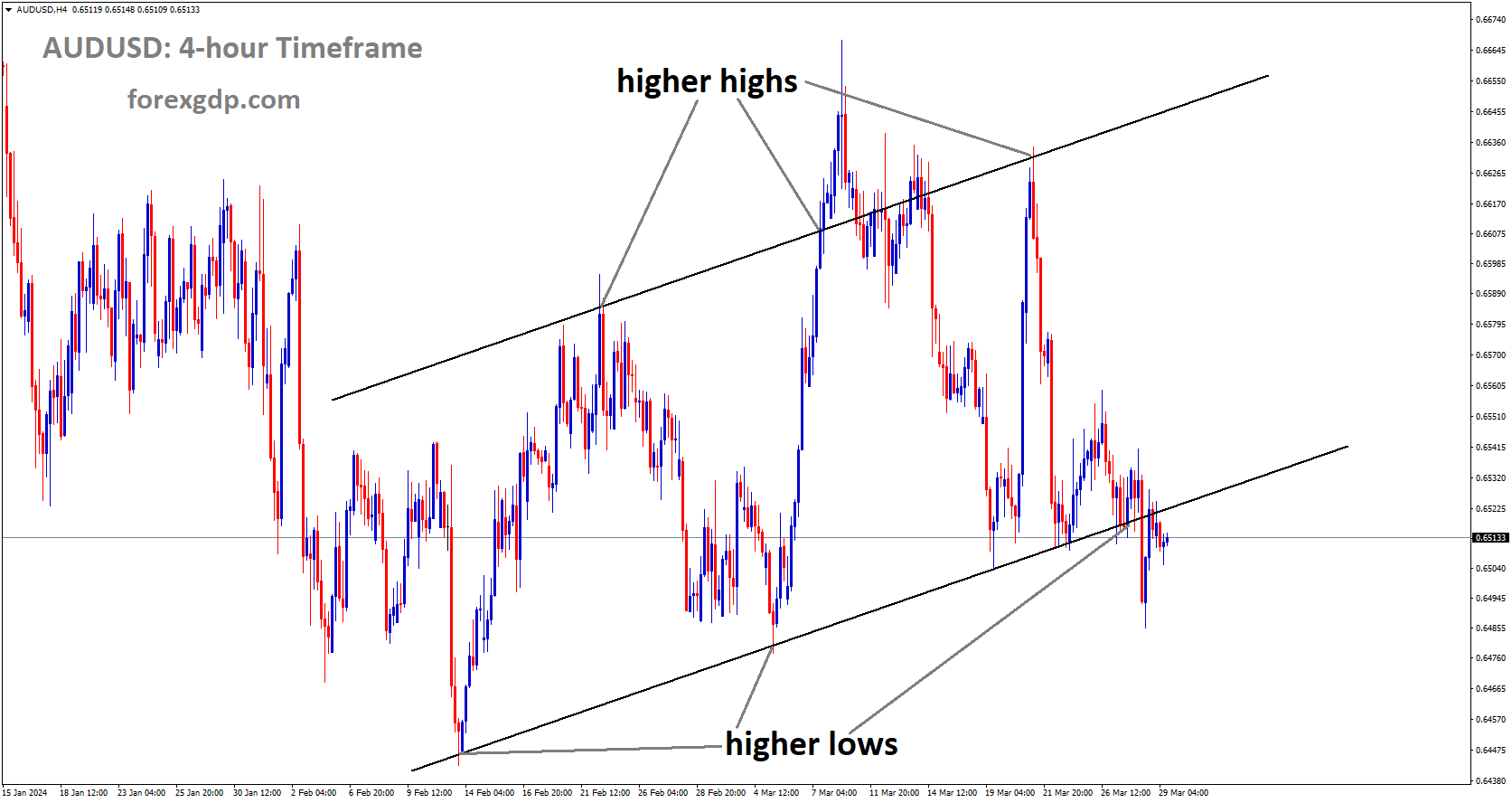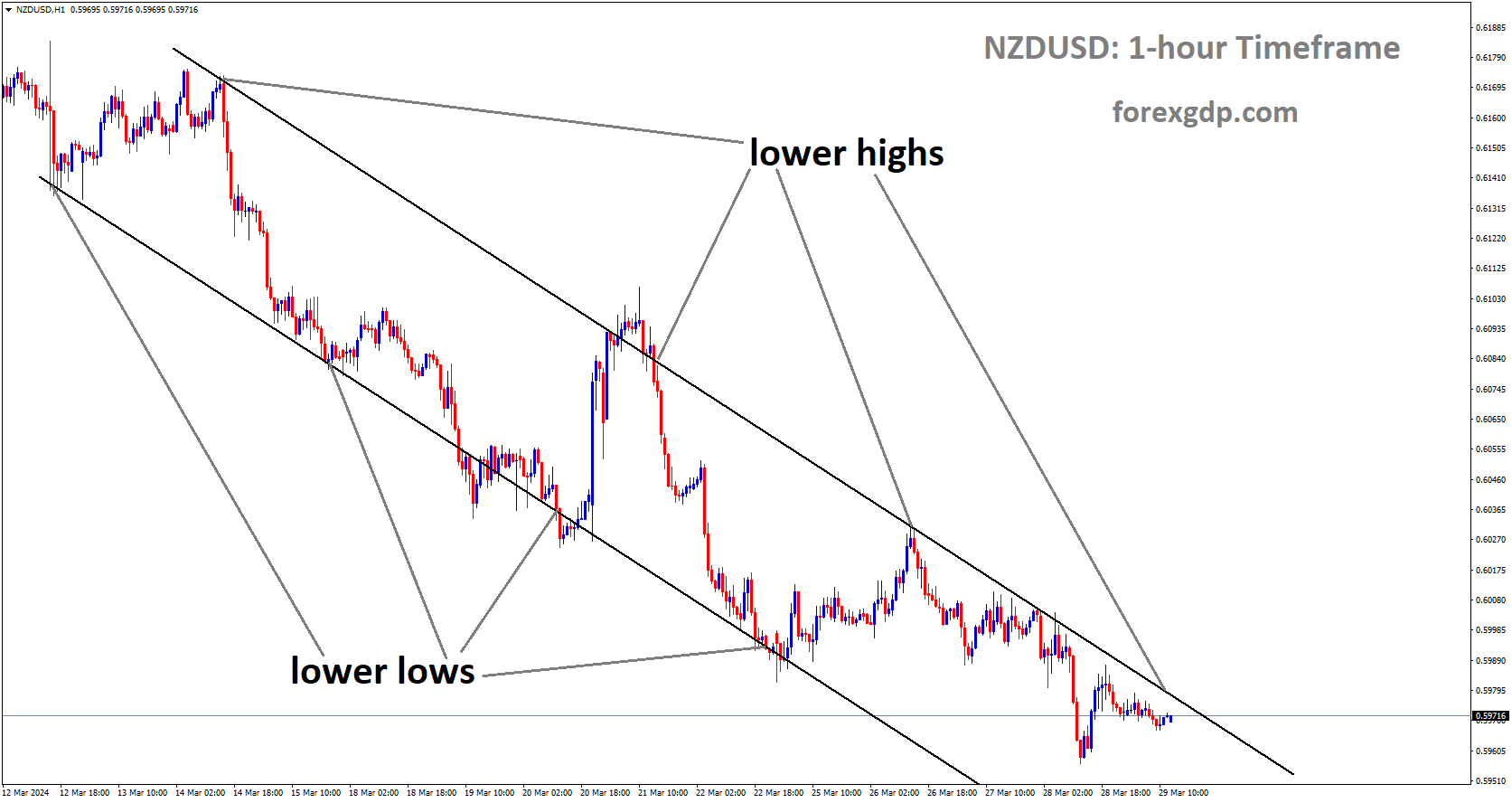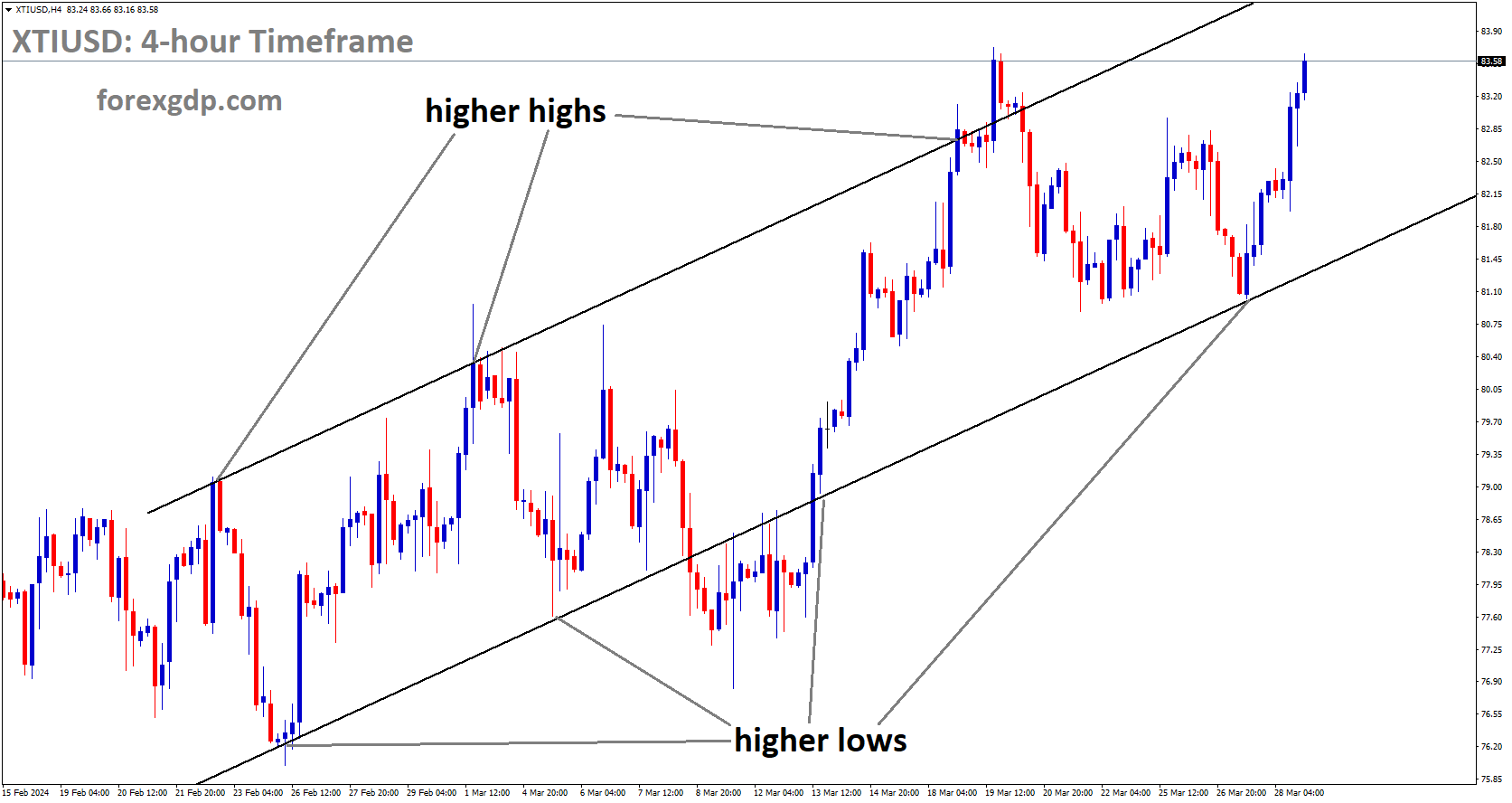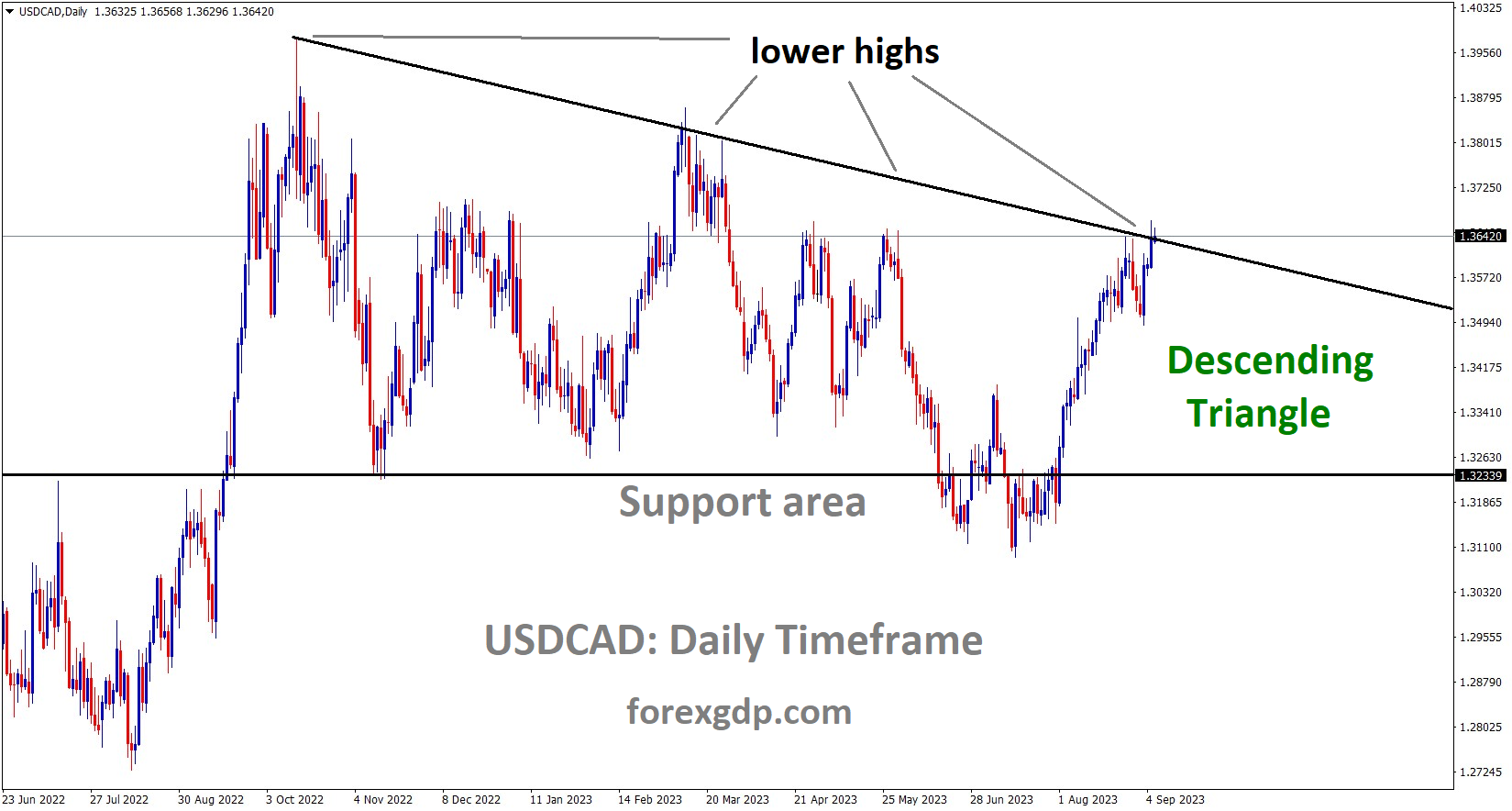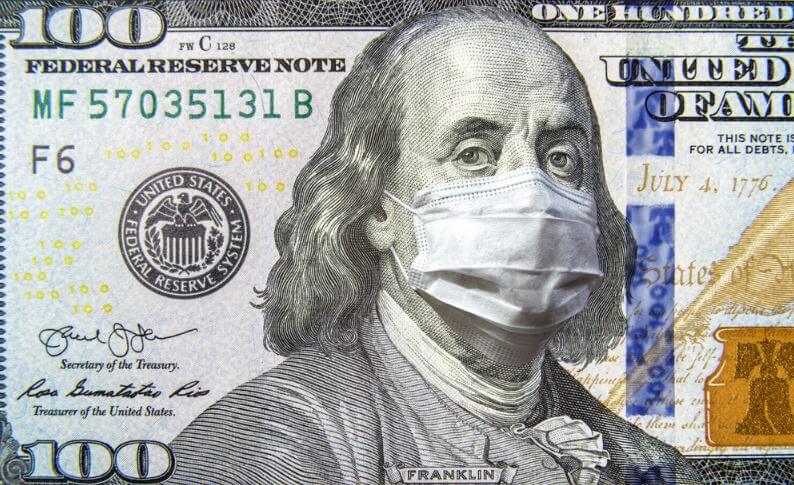XAUUSD is moving in Ascending channel and market has reached higher high area of the channel
XAUUSD – Gold Surge: Fed Speculation and Geopolitical Tensions
Gold Price Surge Amidst Economic Concerns and Fed Rate Cut Speculation:
During the Asian trading session on Friday, the price of gold (XAU/USD) exhibits a notable uptick, approaching all-time highs. This surge is primarily attributed to growing concerns regarding the global economy and the possibility of interest rate cuts by the US Federal Reserve (Fed).
Investors flock to gold as a safe-haven asset amidst uncertainties surrounding economic growth prospects and geopolitical tensions. The prospect of Fed rate cuts adds further fuel to the bullish sentiment surrounding the precious metal, as lower interest rates typically reduce the opportunity cost of holding non-yielding assets like gold.
However, the extent of gold’s upward trajectory may be moderated by the potential strengthening of the US Dollar (USD) in response to the anticipation of reduced interest rates. Since gold is priced in USD, a stronger dollar can weigh on its value, thus capping its upside potential.
Fed Rate Cut Expectations and Market Dynamics:
Market participants are closely monitoring the Fed’s stance on monetary policy, particularly regarding potential interest rate adjustments. Expectations are currently leaning towards the likelihood of multiple rate cuts by the Fed throughout the year, as indicated by various market indicators and analysts’ assessments.
Despite the prevailing sentiment favoring rate cuts, recent statements from Fed officials suggest a degree of caution and a nuanced approach to policy adjustments. This cautious stance may temper market expectations and influence investor sentiment towards gold and other assets.
Geopolitical Tensions and Safe-Haven Demand:
Geopolitical tensions, particularly in the Middle East, contribute to the heightened demand for safe-haven assets such as gold. Reports of escalating conflicts, such as the siege of Gaza hospitals by Israeli forces, underscore the geopolitical uncertainties prevailing in the region.
In times of geopolitical turmoil, investors seek refuge in assets perceived as safe, with gold being a primary beneficiary due to its historical status as a store of value during times of crisis.
Potential Impact of US Economic Data on Market Sentiment:
While financial markets observe reduced activity due to the closure of many exchanges for Good Friday, attention remains focused on the release of key economic data, notably the US February Personal Consumption Expenditures Price Index (PCE).
The PCE data is closely watched by investors as it provides insights into consumer spending patterns and inflationary pressures, which are crucial factors influencing the Fed’s policy decisions. Any significant deviation from expectations in the PCE data could impact market sentiment and potentially alter expectations regarding the timing and magnitude of future Fed actions.
EURUSD – Decline, Fed and ECB Insights
The EUR/USD exchange rate sees a sustained decline, marking its fourth consecutive day of weakening, as the US Dollar (USD) strengthens in response to a cautious tone from the Federal Reserve (Fed). Fed Governor Christopher Waller’s remarks hinting at a potential delay in interest rate cuts due to robust inflation figures fuel market expectations of prolonged higher interest rates, bolstering the USD.
EURUSD is moving in Descending Triangle and market has fallen from the lower high area of the pattern
Amidst these developments, the Euro faces additional pressure following dovish comments from European Central Bank (ECB) policymaker Francois Villeroy. Villeroy acknowledges concerns over declining core inflation but maintains optimism about the ECB’s ability to achieve its inflation goal of 2%. However, he warns of escalating downside risks if the ECB refrains from adjusting its policy stance.
Echoing Villeroy’s sentiments, ECB executive board member Fabio Panetta emphasizes the need for accommodative monetary policies to address economic challenges. Panetta highlights the adverse effects of restrictive policies on demand and inflation, signaling a growing consensus within the ECB regarding the necessity of policy adjustments to support economic recovery.
Against this backdrop, investors eagerly await the release of key US economic data, particularly the US Personal Consumption Expenditures (PCE) report, to gauge inflation trends and gain insights into future Fed actions. The contrasting monetary policy stances between the Fed and the ECB, coupled with evolving economic data, shape the dynamics of the EUR/USD pair and drive market sentiment in the currency markets.
USDJPY – BoJ Caution and Economic Indicators
USD/JPY Under Pressure as BoJ Maintains Cautious Monetary Policy:
The USD/JPY pair experiences pressure as the Bank of Japan (BoJ) continues to pursue a cautious approach to monetary policy, aiming to keep conditions accommodative.
USDJPY is moving in box pattern and market has rebounded from the support area of the pattern
Japanese Prime Minister Fumio Kishida echoes the BoJ’s stance, emphasizing the importance of collaboration between the government and the central bank to promote wage increases and combat deflationary pressures within the economy.
Japanese CPI Data Highlights Inflation Trends:
Recent data reveals that the Japanese Consumer Price Index (CPI) rose by 2.6% year-over-year in March, a slight uptick from the previous month’s 2.5% increase.
However, the Core Tokyo CPI, a key indicator excluding volatile food and energy prices, registers a slightly lower growth rate of 2.9% year-over-year in March, compared to February’s 3.1% rise. These figures offer insights into inflationary trends within Japan, influencing market sentiment around the yen.
USD Strength Supported by Hawkish Fed Sentiment:
The US Dollar (USD) exhibits strength against the Japanese Yen (JPY), buoyed by hawkish statements from Federal Reserve (Fed) officials.
Market participants respond to the Fed’s hawkish stance, particularly after recent data indicates a robust expansion in the United States’ Gross Domestic Product (GDP) during the fourth quarter of 2023, surpassing expectations with a growth rate of 3.4% annualized.
Stability Amidst Comments and Economic Data:
Despite the pressure on the USD/JPY pair, stability is observed during early European trading hours on Friday.
Japanese officials, including Finance Minister Shunichi Suzuki, express concerns over rapid fluctuations in foreign exchange (FX) markets, emphasizing the importance of stable currency movements aligned with economic fundamentals. Authorities signal readiness to intervene if necessary to address disorderly FX movements.
The combination of economic indicators and official remarks contributes to the overall sentiment surrounding the USD/JPY pair, shaping investor expectations and influencing trading dynamics in the currency market.
USDCAD – Holds Firm Amidst Hawkish Fed, Oil Boost
USD/CAD holding firm after staging a notable recovery, marking a pivotal moment for both currencies. The USD exhibited strength, buoyed by hawkish sentiments surrounding the Federal Reserve’s commitment to maintaining higher policy rates. This upward momentum helped the USD recoup earlier losses and assert its position in the market. Conversely, the Canadian dollar found support from an uptick in West Texas Intermediate (WTI) oil prices, signaling a positive outlook for the Canadian economy.
USDCAD is moving in box pattern and market has fallen from the resistance area of the pattern
Trading activity was relatively subdued on Friday, owing to the observance of Good Friday, which typically leads to reduced market participation. Despite this, the USD’s resilience persisted, reflecting investors’ confidence in the Federal Reserve’s unwavering stance on interest rates. This sentiment was further reinforced by recent robust economic data releases from the United States.
Federal Reserve Governor Christopher Waller’s cautious comments also influenced market sentiment, indicating a measured approach to potential rate cuts and tempering expectations of aggressive monetary policy adjustments. This contributed to a more optimistic outlook for the USD.
In terms of economic indicators, the US Gross Domestic Product (GDP) for the fourth quarter exceeded expectations, growing at a solid annualized rate of 3.4%. However, the US Core Personal Consumption Expenditures (PCE) for the same period fell slightly short of projections, registering a 2.0% increase. Despite this minor discrepancy, the overall economic picture for the United States remained robust.
Meanwhile, the Canadian dollar benefited from the surge in WTI prices, which are closely linked to the country’s energy sector. Expectations of sustained production cuts by OPEC+ members further bolstered confidence in the oil market, providing additional support for the Canadian dollar.
On the domestic front, Canada’s Gross Domestic Product (GDP) expanded by a noteworthy 0.6% in January, surpassing initial forecasts and signaling strong economic growth. This positive development alleviated concerns about potential rate cuts by the Bank of Canada (BoC), instilling confidence in the resilience of the Canadian economy.
In summary, Friday’s movements in the USD/CAD pair were influenced by a myriad of factors, including central bank policies, economic data releases, and commodity prices. Despite the subdued trading environment, both currencies showcased their strengths, setting the stage for further market dynamics in the days ahead.
USDCHF- Rebounds on Hawkish Fed, SNB Vigilance
The USD/CHF pair managed to break its two-day losing streak during Friday’s Asian trading session, driven by a confluence of factors affecting both the US dollar and the Swiss franc.
USDCHF is moving in Ascending channel and market has fallen from the higher high area of the channel
One significant factor bolstering the US dollar was the hawkish sentiment expressed by officials from the US Federal Reserve (Fed). Fed Governor Christopher Waller emphasized on Wednesday that the central bank was not in a hurry to lower interest rates, pointing to elevated inflation levels that indicated the current interest rates needed more time to have their desired effect. Additionally, Fed Governor Lisa Cook echoed this sentiment earlier in the week, highlighting the importance of a cautious approach to policy shifts to ensure sustainable inflation returns to the Fed’s target of 2%.
These remarks contributed to a narrative of potentially higher interest rates in the US for a prolonged period, which typically strengthens the US dollar. As a result, the USD/CHF pair found support from this bullish outlook for the greenback.
However, the Swiss franc also faced its own set of dynamics. Swiss National Bank (SNB) Vice President Martin Schlegel reiterated the central bank’s commitment to closely monitoring foreign exchange rates and intervening in the market if necessary. Although the SNB does not have a specific target for the Swiss franc exchange rate, recent actions, such as last week’s surprise interest rate cut, indicate a willingness to take measures to manage the currency’s value.
This interventionist stance by the SNB has the potential to cap the downside of the Swiss franc against the US dollar, despite the prevailing strength of the greenback.
Furthermore, geopolitical tensions in the Middle East added another layer of complexity to the currency markets. Reports of Israeli forces besieging Gaza hospitals escalated tensions, potentially increasing demand for safe-haven assets like the Swiss franc.
Looking ahead, market participants awaited the release of the US Core Personal Consumption Expenditures (PCE) Price Index later on Friday. This inflation gauge, preferred by the Fed, was expected to remain stable at 2.8% year-on-year. However, trading activity was expected to be muted due to the observance of Good Friday, leading to lighter volumes and potentially less pronounced market movements.
EURGBP – Slips as ECB Dovishness Meets BoE Caution
The EUR/GBP pair extended its downward trajectory, influenced by dovish sentiments from European Central Bank (ECB) policymakers, notably Francois Villeroy, who underscored concerns regarding the Eurozone’s economic outlook.
EURGBP is moving in box pattern and market has fallen from the resistance area of the pattern
Villeroy’s remarks centered on a notable decline in core inflation, despite expressing confidence in the ECB’s ability to achieve its 2% inflation target. However, he warned of escalating downside risks should the ECB hesitate to implement rate cuts, highlighting the growing pressure on the Euro.
Adding to the ECB’s dovish tone, Executive Board member Fabio Panetta suggested on Thursday that conditions favor monetary policy easing. He highlighted the dampening effect of restrictive policies on demand, contributing to a rapid decline in inflation. Panetta also noted a reduction in risks to price stability, signaling a potential shift in ECB policy.
In contrast, the Pound Sterling (GBP) held its ground, partly attributed to hawkish remarks from Bank of England (BoE) official Jonathan Haskel. Haskel emphasized that rate cuts should be “a long way off,” echoing a sentiment shared by colleague Catherine Mann, who cautioned against high expectations for interest rate cuts this year.
Despite the BoE’s cautious stance on rate cuts, the GBP faced downward pressure following economic data indicating a recession in the UK economy in the latter half of 2023. The UK’s GDP contracted by 0.3% quarter-on-quarter in Q4 2023, aligning with preliminary estimates.
Speculation persists regarding the BoE’s future actions, with expectations of three quarter-point rate reductions throughout 2024. BoE Governor Andrew Bailey hinted at potential interest rate cuts in upcoming policy meetings, underscoring the uncertainties surrounding the UK’s economic trajectory.
GBPUSD – UK Recession and US Growth Impact Currency Markets
UK GDP Contraction and US Q4 GDP Expansion:
In the fourth quarter of 2023, the UK Gross Domestic Product (GDP) contracted by 0.3% quarter-over-quarter (QoQ), remaining unchanged from preliminary estimates. This contraction signals ongoing economic challenges within the UK.
Conversely, the final figures for US Q4 GDP reveal an expansion of 3.4%, surpassing both the previous estimate of 3.2% and market expectations. This robust growth underscores the resilience of the US economy.
GBPUSD is moving in box pattern and market has reached support area of the pattern
Focus on US February Core PCE:
Market attention shifts to the US February Core Personal Consumption Expenditures (PCE) Price Index, slated for release on Friday. This index serves as the Federal Reserve’s preferred measure of inflation.
Analysts anticipate the index to hold steady at 2.8% year-over-year (YoY), with any deviations likely to influence market sentiment and expectations regarding future Fed policy actions.
Market Expectations Amid Light Good Friday Trading:
With trading expected to be subdued on Good Friday, market activity may remain muted. However, investors remain vigilant for potential market-moving developments.
Of particular interest is the release of the US Core PCE Price Index later in the day, which could provide insight into inflationary trends and impact currency valuations.
GBP Reaction to UK Recession and BoE Speculation:
The Pound Sterling (GBP) faces downward pressure following news of the UK economy slipping into recession during the latter part of 2023.
Despite the contraction of 0.3% QoQ in Q4, aligning with initial estimates, its impact on monetary policy expectations is limited, as investors had already priced in the possibility of a mild recession.
Speculation mounts regarding potential interest rate cuts by the Bank of England (BoE) throughout the year. Governor Andrew Bailey’s indication that rate reductions are being considered at future policy meetings adds to market uncertainty surrounding the GBP.
US Economic Strength and Its Influence on Currency Markets:
The robust performance of the US economy in Q4 2023 bolsters the US Dollar (USD) and exerts downward pressure on the GBP/USD pair.
The better-than-expected Q4 GDP growth, along with positive data such as weekly Initial Jobless Claims and an upward revision of the March Michigan Consumer Sentiment Index, reaffirms confidence in the US economic outlook.
Consequently, the USD’s strength is further solidified, contributing to the prevailing currency dynamics between the GBP and USD.
AUDUSD – AUD Weakens, USD Gains on Central Bank Speculation
AUD Struggles Amid RBA Dovish Stance Speculations:
The Australian Dollar (AUD) faces continued pressure as market sentiment leans towards the Reserve Bank of Australia (RBA) adopting a dovish stance.
Speculations arise that the RBA may consider interest rate cuts in the latter half of 2024, influencing investor sentiment towards the AUD.
AUDUSD is moving in Ascending channel and market has reached higher low area of the channel
USD Strengthens on Fed Rate Cut Delay Speculations:
The US Dollar (USD) sees strength on recent indications suggesting that the Federal Reserve (Fed) could delay implementing rate cuts.
Hawkish comments from Fed officials, including Governor Christopher Waller, hint at a possible delay in rate cuts amid robust inflation data, bolstering the USD.
AUD Performance and Market Outlook:
The AUD extends losses for the second consecutive session, with subdued market activity expected due to Good Friday trading conditions.
Weaker Australian economic indicators, such as Consumer Inflation Expectations and Retail Sales figures, raise expectations of potential RBA rate cuts, contributing to AUD weakness.
Australian Economic Indicators and Government Policies:
Australian Consumer Inflation Expectations for March show a slight decrease to 4.3%, while Retail Sales figures for February fall short of expectations.
The Monthly Consumer Price Index (YoY) for February remains consistent at a 3.4% rise, slightly below forecasts.
The Australian government pledges support for a minimum wage increase aligned with inflation to address challenges faced by low-income families amidst rising living costs.
Global Economic Landscape:
Insights from the Boao Forum for Asia (BFA) highlight China’s stance on inclusive economic globalization, emphasizing opposition to unilateralism and protectionism.
Federal Reserve officials, including Governor Christopher Waller and Atlanta Fed President Raphael Bostic, express cautious views on rate cuts amid sticky inflation data and economic conditions.
US Economic Performance:
US Gross Domestic Product (GDP) expands by 3.4% in the fourth quarter of 2023, surpassing market expectations.
Core Personal Consumption Expenditures (PCE) and Gross Domestic Product Price Index remain consistent, while Initial Jobless Claims fall, reflecting a positive economic outlook for the US.
NZDUSD – US Growth, RBNZ Outlook, PCE Awaited
In a surprising turn, the US economy outpaced expectations in the fourth quarter (Q4). Governor Orr of the Reserve Bank of New Zealand (RBNZ) signaled a tightening stance to rein in inflation, hinting at imminent rate cuts.
NZDUSD is moving in Descending channel and market has reached lower high area of the channel
Attention now turns to the US February Core Personal Consumption Expenditures (PCE) data due Friday. The NZD/USD pair faces downward pressure, influenced by dovish remarks from RBNZ’s Orr, while anticipation builds for fresh market drivers from the upcoming US PCE figures.
Recent figures reveal the US economy’s robust expansion in Q4, fueled by strong consumer spending and corporate investments, as per the latest release from the Bureau of Economic Analysis. The final estimate of Q4 Gross Domestic Product (GDP) surged to an annual rate of 3.4%, up from the previous 3.2%, leading to a rise in the US Dollar (USD).
Meanwhile, Governor Orr’s comments affirm RBNZ’s commitment to inflation targets, with hints of impending rate cuts, possibly as early as next year. Although investors anticipate rate cuts by August, Orr’s statements exert downward pressure on the NZD, posing challenges for the NZD/USD pair.
Friday’s highlight rests on the US Core PCE data, with projections indicating a 0.3% MoM and 0.8% YoY increase for February. A stronger-than-expected report could bolster the USD. Additionally, speeches by Fed Chair Jerome Powell and Fed Bank of San Francisco President Mary Daly are anticipated, adding to market dynamics later in the day.
CRUDE OIL – WTI Prices Rise Amid OPEC+ Talks and Geopolitical Tensions
WTI crude oil prices experienced a notable uptick as speculation grew regarding OPEC+’s commitment to maintaining ongoing production cuts. This anticipation was fueled by the expectation that the alliance would continue its efforts to stabilize the oil market by limiting output. Concurrently, the conflict between Ukraine and Russia escalated, with Ukrainian attacks targeting Russian infrastructure. These assaults not only added to existing geopolitical tensions but also contributed to a perception of constrained global crude oil supplies, further buoying prices.
XTIUSD is moving in Ascending channel and market has rebounded from the higher low area of the channel
Meanwhile, in Baltimore, the collapse of the Francis Scott Key Bridge had significant ramifications for the local fuel supply chain. With parts of the bridge collapsing into shipping lanes at the mouth of the Port of Baltimore, the city’s port was forced into an indefinite closure. This closure disrupted the flow of goods and services, including fuel deliveries, leading to anticipated delays and logistical challenges for fuel suppliers operating in the area.
As markets observed the holiday closure for Good Friday, attention remained on the dynamics shaping crude oil prices. The likelihood of OPEC+ maintaining its production cuts remained a focal point, with investors closely monitoring developments within the alliance. Despite mounting geopolitical risks and concerns over potential supply disruptions, it was assessed that OPEC+ would refrain from altering its oil output policies until its scheduled ministerial gathering in June.
Additionally, the Energy Information Administration (EIA) released a report indicating a surprising increase in US crude inventories for the week ending on March 22. This unexpected rise, contrary to market expectations of a decline, added another layer of complexity to the oil market dynamics.
On the economic front, the US Gross Domestic Product (GDP) exhibited robust growth, expanding by 3.4% in the fourth quarter of 2023, surpassing earlier forecasts. This growth was accompanied by stability in the GDP Price Index, which saw a moderate increase of 1.7%, aligning with expectations for the period.
Looking ahead, investors awaited the release of the US Personal Consumption Expenditures (PCE) price index report, scheduled for Friday. This report, considered a key indicator of inflation by the Federal Reserve, was anticipated to provide insights into the trajectory of interest rates, further influencing market sentiments and investment strategies.
Don’t trade all the time, trade forex only at the confirmed trade setups.
Get more confirmed trade setups here: forexgdp.com/buy/

